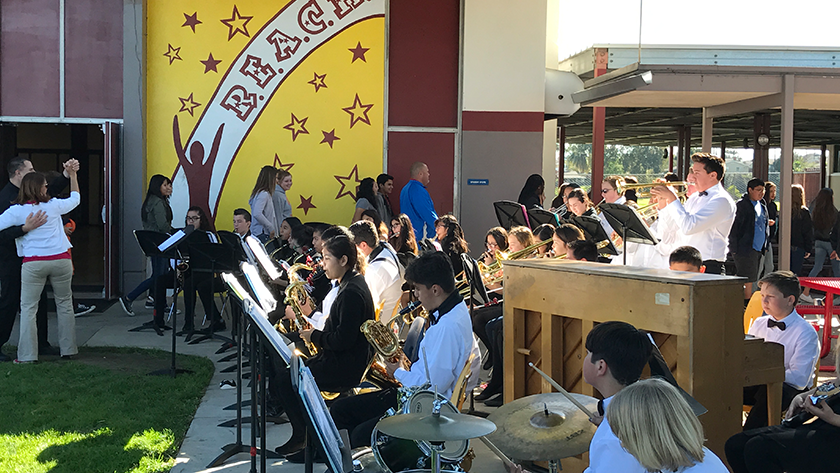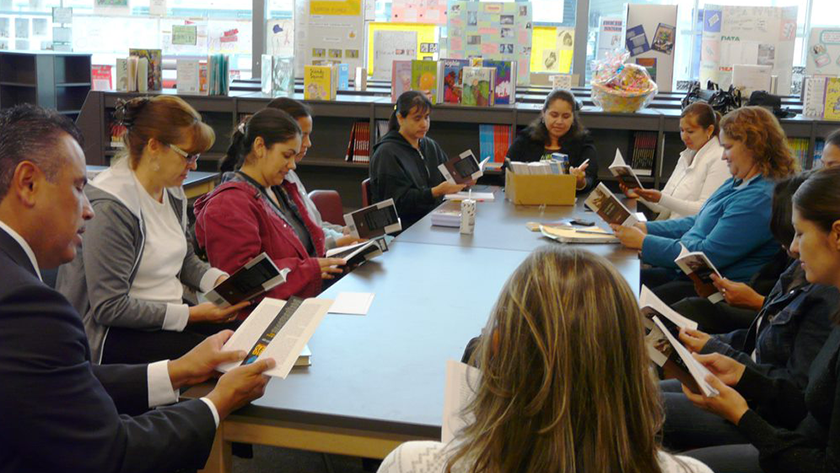
Band students play an outside concert.
PHOTO COURTESY OF LOWELL JOINT SCHOOL DISTRICT
A music program that offers a connection and community to elementary and junior high students; a preschool-to-12th-grade dual language program; and a program that empowers parents to become leaders and advocate for their children and community. These are among the winning programs for the 2022 Magna Awards.
For more than 25 years, the Magna Awards have recognized innovative school district programs. Our winning programs—the Grand Prize winners and the Silver Award winners—represent the enormous efforts of school leaders and district staff to remove barriers to achievement for their underserved and vulnerable students.
We present these winning programs with the hopes that you will discover information that you can use in your districts, especially during these times of crisis. Our profiles give you an overview of the programs, including evidence of success. We include district contact information so you can find out more from the school leaders and staff who manage these initiatives.
In addition to the following stories, we created an opportunity for you to learn from the three Grand Prize-winning districts. They will be presenting their equity programs at NSBA’s Annual Conference, April 2 through 4 in San Diego.
We invite you to connect with your peers to gain insights and practical ideas to create more equitable schools for your students.
Arts for ALL: Let the Music Play

ARTS for ALL: Let the Music Play is a data-driven program with a laser focus on: 1) engaging students in a program that helps them discover the passion within, 2) discover and foster a “school family” and a place to belong, which will carry them through to high school and postsecondary education, and 3) connect each student with a positive school mentor who speaks life into them.
Let the Music Play serves as an innovative and exemplary program in its ability to employ a creative and personalized approach with a common aim on a system-wide basis while reaching a significant number of students. Students in all five elementary schools and the entire junior high school have a common goal: engaging to discover their passion, discovering and fostering “school family,” and connecting with a positive school mentor who speaks life into them. This is accomplished by encouraging and allowing all sixth-grade students to take instrumental music every week of the school year. About 82 percent of sixth-graders participate in these classes.
Once the sixth-graders matriculate to the junior high instrumental music program, they have multiple paths in which to stay engaged and make a home in music: wind ensemble, drums, advanced drums, intermediate band, concert band, drumline, and jazz band. If a student does not have an instrument, one is provided. If a student has never played, they are embraced and provided additional support to catch up.
To support the expanded number of students, graduate assistants from local universities support the classroom instructor, and all students receive direct support and instruction. The district’s education foundation, local families, and the educational budget provide additional instruments each year to make sure no student is left out or limited as they pursue their passion for music and discover their “school band family.”
The program provides free expanded learning opportunities for all students. These include after-school drumline practices, after-school jazz practices, Saturday workshops, and individualized instruction when needed or requested.
The program also benefits from partnerships within the local community. In addition to the graduate assistants, college music students are hired as sectional coaches. High school mentors provide the support that helps bridge the students to the high school program.
The district annually completes a data study to help evaluate the program’s effectiveness, which has shown that students who participate have grade point averages that are 1.5 points higher (average GPA is 3.7) than those who do not participate. They have 50 percent fewer absences and 60 percent fewer discipline referrals.
The 11-year-old program is supported by the district general fund budget and supplemental state funds. This helps cover all operational costs of the program, which is approximately $100,000 per year. The school board has given clear direction that it will continue to provide necessary resources to ensure the program continues for many years to come.
“I love the inclusivity of the program. It is open to all. Music instruction can be expensive, but here any student interested will be able to participate at no cost,” says school board member Staci Shackelford.
Lowell Joint School District is composed of five elementary schools and one intermediate school. It is highly diverse ethnically and economically, with over 24 languages represented among families. Based on a total district enrollment of 3,144 students in the 2021-22 school year, the district’s demographics are 69 percent Hispanic, 2 percent Black, 19 percent white, 5 percent multiracial, and 5 percent Asian. Also, 24 percent of students are English learners, and 43.5 percent are economically disadvantaged.
Says Superintendent Jim Coombs, “Lowell Joint School District seeks to assure every student has and takes advantage of the chance to discover their passion, connect with a positive adult, and develop a school family. We believe that one of the most successful ways to make this happen is through our band program.”
Dual Language Across All Grades


Dual language classroom enrollment balances native English speakers and native Spanish speakers.
PHOTO COURTESY OF TOPEKA PUBLIC SCHOOLS
The Hispanic population in Topeka Public Schools has steadily increased every year since 2008. Currently, one in three district students identifies as Hispanic. Kansas has seen a similar increase in population growth, gaining over 82,000 Hispanic individuals from 2010 to 2020. This growth in the Hispanic population has an impact on all industries and sectors. Students benefit from receiving a bicultural and biliterate education, particularly as this demographic trend continues.
Topeka Public Schools responded by broadening its scope to provide more diverse and inclusive instructional offerings to students within and beyond the district’s attendance area and started a cohort dual language model at the elementary level in 2009, at the middle school level in 2016, and at the high school level in 2019. Topeka Public Schools will graduate its first class of dual language scholars in the spring of 2022.
The district is considered one of the largest and most diverse school districts in the state, with a student enrollment that is approximately 38 percent white, 32 percent Hispanic, 17 percent African American, and 13 percent other races/ethnicities. Currently, 78 percent of the 13,100 student population rely on free and reduced-price lunches; 400 students are considered homeless.
The preschool-to-12th grade dual language program integrates native English-speaking students with native Spanish-speaking students for academic instruction, which is presented in both languages. Social and academic learning occurs in an environment that values the language and culture of all students and sets high standards to ultimately achieve academic success in Spanish and English.
Dual language classroom composition balances native English speakers and native Spanish speakers to enable all students to be language models and second language learners. Each teacher speaks only in the designated language and communicates using a range of research-based and engaging strategies to promote student understanding and language development. Students within the program demonstrate skillfulness at acquiring language in meaningful contexts through reading, writing, listening, speaking, and thinking in two languages.
Research has established that the most efficient method of learning academic English is through a strong education in the native language. For English learners, this method of instruction eliminates the barrier of understanding content due to not understanding the language. This results in students falling behind academically. Though students may eventually learn the target language, their academic success is lower than when they receive instruction in their native language while simultaneously learning English and will not be behind their peers academically when they achieve fluency in English.
“Topeka Public School’s dual language program has reduced linguistic barriers while increasing cognitive, social, and economic opportunities for ALL its students. It is the primary reason my children attend this amazing school district,” says Topeka school board member Melanie Stuart-Campbell.
Although the Kansas State assessments have changed along this 12-year journey, recent comparable data show a 4 percent increase in exceeding English Language Arts standards for dual language third-graders. There has been growth across all grade levels from 2018 to 2020 in literacy. There was 30 percent proficiency growth in low-income, special education, and English learner populations. The district also has celebrated a 6 percent growth of exceeding standards in math on its state assessments.
The budget for this program is a standard school-based budget, and includes $60,000, which is the cost of a dual language coordinator. The dual language program represents about 9 percent of the Topeka Public Schools’ total budget.
“Our dual language program develops globally competitive leaders for the future as our scholars graduate with bilingual and biliteracy skills,” says Topeka Superintendent Tiffany Anderson. “I am so grateful for the courage of our school board members as advocates for equity in supporting the establishment of the first and only K-12 dual language program in Kansas.”
Parent Leads


Superintendent Richard Martinez joins parents in a reading circle.
PHOTO COURTESY OF POMONA UNIFIED SCHOOL DISTRICT
The Parent Leads program started in 2008 to disseminate information on district and community resources and then have parents take what they learned back to their school sites to share with other parents. It has since grown beyond this original mandate to encourage active engagement that builds the capacity of parents and develops their leadership skills; has led to employment opportunities and educational avenues for the parents themselves; and has opened families to educational opportunities for their children.
Parent Leads are natural leaders at their own school sites, such as PTA or school site council members. Through Parent Leads, their roles are augmented by attending workshops on what their students are learning, how the educational system and community work, and how they can become advocates for their children.
Parents interact not only with their school site but make their voices heard throughout the district, speaking directly with site and district administrators and the school board. Parent Leads meet with community representatives, including city, state, and congressional representatives, to learn about health and social resources to support families in crisis. Parent Leads take this information back to their neighborhoods and friends, and they become active partners in education and in the Pomona community.
The Pomona Unified School District is an urban district in Los Angeles County with a K-12 student enrollment of 21,810. It has 41 schools and serves a student population that is 87 percent Hispanic. Over 27 percent of students are English learners, and 88 percent are in poverty. For many families in Pomona, their children in school today will be the first to earn a high school diploma.
Parent Leads meetings provide a forum on civic and district events. Speakers range from volunteers for various organizations to school board members, to district administrators, and to Congressional representatives.
Superintendent Richard Martinez may attend to explain how the district’s community services work or why dual language Immersion in English/Spanish or English/Mandarin will help their children. There may be a discussion of upcoming workshops at school sites offering training in English, nutrition, and health services. Parent Leads then go back to their schools and brainstorm with school leadership on how best to disseminate the information to ensure participation by all families.
Parent Leads act as recruiters, inviting parents to participate as volunteers, PTA/PTO members, and parent representatives at school and district meetings. Through the active support of Parent Leads, the district now has Parent Centers throughout its school sites where families and the entire community are welcomed to engage in learning English, computer training, arts and crafts, yoga, salsa dancing, applying for a driver’s license, as well as in educational and health workshops and other requested training.
In the Parent Centers, families also have access to computers and learn how to monitor their students’ academic growth and achievement online through the district portal.
Parents learn about financial literacy and college scholarships available to their students. The Parent Leads program is there to explain the benefits of a college diploma and how the college-going experience works. They provide support to ensure that both families and students successfully transition into the college experience.
Board members have prioritized this program. Every board member has attended Parent Leads meetings and works to ensure positive affiliations with parents. They also are accessible to hear parents’ suggestions on how best to open the door to educational experiences for their children.
The program began with seven parents and now has more than 80 parents throughout the district attending each monthly session. Parent leaders have come from within the group. They not only attend the Parent Leads meetings, but also are readily available to assist with other matters that promote education.
Parent Leads are a vital support for the district’s programs. Parents are fully integrated partners with the district and community. Their recommendations are listened to and implemented. They contribute to the board’s vision of education, and they are helping to shape opportunities for success for their students.

Share this content